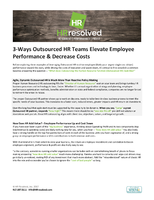Wireless Monitoring System helps data centers save energy.
Share:
Press Release Summary:
Utilizing PhyNet(TM) non-disruptive IP-based wireless sensor network technology, Arch Rock Energy Optimizer-Data Center Edition measures both power and cooling system efficiency in data centers. Managers can baseline data center against ASHRAE benchmarks; identify factors that cause energy waste, hot spots, or other harmful conditions; and optimize available capacity for new servers based on actual electrical/cooling consumption of equipment.
Original Press Release:
Arch Rock 'Energy Optimizer' Lets Data Centers Conserve Energy While Meeting Efficiency Goals
Wireless Sensor Network System Continuously Monitors Power and Thermal Use, Pinpointing Common Waste Areas; Users Can Match Cooling Load to Power Load, Improve PUE
SAN FRANCISCO, Calif., Oct. 26, 2009 - Arch Rock has introduced a wireless monitoring system that provides continually updated information on a data center's electrical usage and thermal status, giving users the precise knowledge to take energy-conservation measures while maximizing the operational efficiency and reliability of their servers and other computing equipment.
Arch Rock Energy Optimizer-Data Center Edition (AREO-DC) is the first solution to measure both power and cooling system efficiency in the data center using non-disruptive Internet Protocol (IP)-based wireless sensor networks. It lets data
center managers:
as well as for actual dollars spent on energy and its carbon equivalent;
How Energy Optimizer Works in the Data Center
AREO-DC works by deploying wireless sensors to measure electrical, thermal, flow and pressure conditions on power circuits, server racks, computer-room air conditioners
(CRACs) or air handlers (CRAHs), chillers and underneath the raised computer-room floor. The sensed data is then transmitted via wireless sensor networks to a graphical, multi-window dashboard that shows the electricity load (and associated utility rate-adjusted spend rate) of various equipment, electricity usage by physical or functional area over user-selected time intervals; temperature and humidity
data from CRACs, CRAHs, server racks and chillers over time; chiller water-flow rates; "heat maps" superimposed on a floor plan; and key performance indicators such as the Green Grid organization's Power Usage Effectiveness (PUE) Level 3 standard.
From the AREO-DC dashboard, users can drill down to specific data centers and specific racks within a data center, and bring up side-by-side views of various factors,
such as energy usage vis- -vis indoor and/or outdoor temperature. Alerts can be generated when heat- and energy-use thresholds or user-defined financial thresholds
are exceeded.
Energy Optimizer Family Expands With Addition of Thermal Monitoring
The new product extends Arch Rock's original Energy Optimizer, introduced in April 2009, with upgraded software and new thermal, flow and pressure sensor nodes. The
earlier product provided real-time, circuit-level visibility into a building's electric power consumption, letting facilities managers boost efficiency and gear usage
patterns to accommodate utilities' demand-response and other incentive programs. To this power-monitoring and analysis function, AREO-DC now adds thermal efficiency
monitoring, which is critical to a densely-packed data center, where efficient cooling plant operation is vulnerable to seemingly minor rack or floor openings or tiny variations in air flow.
Because it relies on Arch Rock's PhyNet(tm) enterprise-class IP-based wireless sensor network (WSN) technology, AREO-DC can be used to securely monitor and centrally manage
multiple data centers and/or other facilities located in remote locations, as part of the corporate IT infrastructure.
Keeping Server Racks Cool Enough, But No Cooler Than Necessary
"Conserving power is a major concern in today's data centers," said Roland Acra, Arch Rock CEO. "In the past, data center managers often overprovisioned CRACs, CRAHs and
chillers to give themselves a 'safety zone.' Now they are being encouraged to raise set points to save energy. But they lack the data to answer key questions: How high can they raise temperatures without creating hot spots that will lead to server shutdowns? Are there plenum leaks or missing blanking panels that waste energy? Are air-conditioning units fighting each other, one humidifying and the other dehumidifying? What is the best new topology for server consolidation using the existing cooling and power-distribution system?
"These questions can only be answered by understanding the relationship between power consumption and the cooling infrastructure. For that you need continuous, precise
measurements of both electricity usage and cooling-equipment performance - especially supply air temperature into the server racks. While many systems can give a Power
Usage Effectiveness (PUE) figure, only AREO-DC provides the data to improve that PUE while conforming to ASHRAE recommendations. And because it's wireless, it's practical
to deploy and redeploy tens or hundreds of sensors where needed."
AREO-DC can help data center managers, for example:
Components of Energy Optimizer-Data Center Edition
Components of Energy Optimizer-Data Center Edition include:
temperatures at various heights from the raised floor and to generate heat maps.
All wireless nodes are battery-operated with an optional AC wall adapter, and support over-the-air (OTA) software upgrades.
Pricing and Availability
Arch Rock Energy Optimizer-Data Center Edition is available now. The Energy Portal is offered as a hosted service or an on-site customer premise appliance. An example starter configuration including the Energy Portal (one-year subscription to hosted service), one PhyNet Router, three IPpower Nodes (monitoring up to nine circuits), four
IPthermal-XT nodes (up to 28 temperature measurement points and four humidity points), one IPthermal-HT node (up to four combined thermal and humidity measurement points), two IPpressure nodes (up to six differential pressure measurement points), and two IPrelay (extender) nodes, is priced at $9,995 (U.S. list).
About Arch Rock Corporation
Arch Rock is a pioneer in IP-based wireless sensor network (WSN) technology, focusing on energy and environmental monitoring applications. The company's PhyNet(tm) WSN
architecture is the foundation for turning autonomous wireless sensing points into IP- and Web-enabled devices that can communicate data locally or globally, enabling
ubiquitous, non-disruptive and cost-effective instrumentation for improved energy and environmental management. Arch Rock's Energy Optimizer solution allows enterprises to better monitor, analyze and optimize their use of energy resources while maintaining safe, reliable and comfortable environmental conditions in their buildings, campuses and data centers. For more information, visit www.archrock.com.




